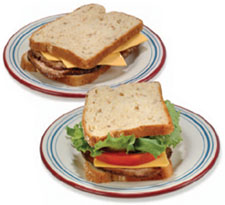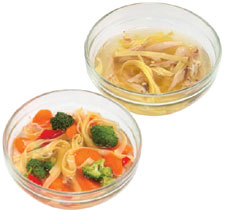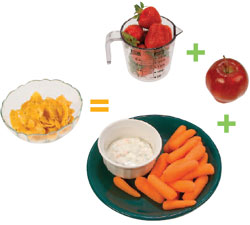|
Our Services Follow Us
Benefits of In Home Personal Training
-Personal Trainers in Maryland
-Personal Trainers in Pennsylvania
-Personal Trainers in Virginia
Every Body's Personal Trainer Accessories
Free Resources Personal Trainer/Owner Eric Leader's Blog
Company Information Every Body's Personal Trainer in the Media/Press
Physique Transformation Competition
Every Body's Personal Trainer Client Feedback
Call Now!!! (443) 615-2702 Or
Follow Us
|
How to Use Fruits and Vegetables to Help Manage Your Weight
Fruits and vegetables are part of a well-balanced and healthy eating plan. There are many different ways to lose or maintain a healthy weight. Using more fruits and vegetables along with whole grains and lean meats, nuts, and beans is a safe and healthy one. Helping control your weight is not the only benefit of eating more fruits and vegetables. Diets rich in fruits and vegetables may reduce the risk of some types of cancer and other chronic diseases. Fruits and vegetables also provide essential vitamins and minerals, fiber, and other substances that are important for good health.
 To
lose weight, you must eat fewer calories than your body uses.
To
lose weight, you must eat fewer calories than your body uses.
This doesn’t necessarily mean that you have to eat less food. You can create lower-calorie versions of some of your favorite dishes by substituting low-calorie fruits and vegetables in place of higher-calorie ingredients. The water and fiber in fruits and vegetables will add volume to your dishes, so you can eat the same amount of food with fewer calories. Most fruits and vegetables are naturally low in fat and calories and are filling.
Here are some simple ways to cut calories and eat fruits and vegetables throughout your day:
Breakfast: Start the Day Right
| Substitute some spinach, onions, or mushrooms for one of the eggs or half of the cheese in your morning omelet. The vegetables will add volume and flavor to the dish with fewer calories than the egg or cheese. | |
| Cut back on the amount of cereal in your bowl to make room for some cut-up bananas, peaches, or strawberries. You can still eat a full bowl, but with fewer calories. |
 Lighten
Up Your Lunch
Lighten
Up Your Lunch
| Substitute vegetables such as lettuce, tomatoes, cucumbers, or onions for 2 ounces of the cheese and 2 ounces of the meat in your sandwich, wrap, or burrito. The new version will fill you up with fewer calories than the original. | |
| Add a cup of chopped vegetables, such as broccoli, carrots, beans, or red peppers, in place of 2 ounces of the meat or 1 cup of noodles in your favorite broth-based soup. The vegetables will help fill you up, so you won’t miss those extra calories. |
Dinner
 Add
in 1 cup of chopped vegetables such as broccoli, tomatoes, squash, onions, or
peppers, while removing 1 cup of the rice or pasta in your favorite dish. The
dish with the vegetables will be just as satisfying but have fewer calories
than the same amount of the original version. Add
in 1 cup of chopped vegetables such as broccoli, tomatoes, squash, onions, or
peppers, while removing 1 cup of the rice or pasta in your favorite dish. The
dish with the vegetables will be just as satisfying but have fewer calories
than the same amount of the original version. | |
| Take a good look at your dinner plate. Vegetables, fruit, and whole grains should take up the largest portion of your plate. If they do not, replace some of the meat, cheese, white pasta, or rice with legumes, steamed broccoli, asparagus, greens, or another favorite vegetable. This will reduce the total calories in your meal without reducing the amount of food you eat. BUT remember to use a normal- or small-size plate — not a platter. The total number of calories that you eat counts, even if a good proportion of them come from fruits and vegetables. |

Smart Snacks
| Most healthy eating plans allow for one or two small snacks a day. Choosing most fruits and vegetables will allow you to eat a snack with only 100 calories. |
The fruits and vegetables in the box above all have about 100 or fewer
calories.
Instead of a high-calorie snack from a vending machine, bring some cut-up
vegetables or fruit from home. One snack-sized bag of corn chips (1 ounce) has
the same number of calories as a small apple, 1 cup of whole strawberries, AND 1
cup of carrots with 1/4 cup of low-calorie dip. Substitute one or two of these
options for the chips, and you will have a satisfying snack with fewer calories.

Remember: Substitution is the key.
It’s true that fruits and vegetables are lower in calories than many other
foods, but they do contain some calories. If you start eating fruits and
vegetables in addition to what you usually eat, you are adding calories and may
gain weight. The key is substitution. Eat fruits and vegetables instead of some
other higher-calorie food.
More Tips for Making Fruits and Vegetables Part of Your Weight Management Plan
Eat fruits and vegetables the way nature provided—or with fat-free or
low-fat cooking techniques.
Try steaming your vegetables, using low-calorie or low-fat dressings, and
using herbs and spices to add flavor. Some cooking techniques, such as breading
and frying, or using high-fat dressings or sauces will greatly increase the
calories and fat in the dish. And eat your fruit raw to enjoy its natural
sweetness.
Canned or frozen fruits and vegetables are good options when fresh produce
is not available.
However, be careful to choose those without added sugar, syrup, cream
sauces, or other ingredients that will add calories.
Choose whole fruit over fruit drinks and juices. Fruit juices have lost
fiber from the fruit.
It is better to eat the whole fruit because it contains the added fiber that
helps you feel full. One 6-ounce serving of orange juice has 85 calories,
compared to just 65 calories in a medium orange.
Whole fruit gives you a bigger size snack than the same fruit dried—for
the same number of calories.
A small box of raisins (1/4 cup) is about 100 calories. For the same number
of calories, you can eat 1 cup of grapes.
